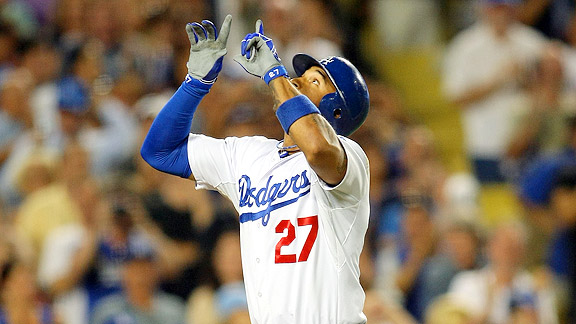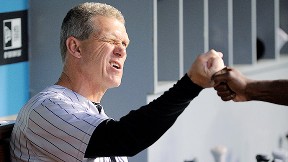All this and Mt. Kilimanjaro too? Mets knuckleballer R.A. Dickey is everything Dodger fans wanted Charlie Haeger to be and more.
You might have thought climbing the big mountain or publishing a book might be Dickey’s biggest accomplishments of the year, but perhaps not.
Dickey, as David Schoenfield of ESPN.com notes, has not only thrown consecutive one-hitters, but in his past six starts, “Dickey is 6-0 with a 0.18 ERA (one earned run in 48 2/3 innings), 63 strikeouts, five walks and a .131 average allowed.”
Venerable New Yorker writer Roger Angell offered this:
… Dickey, whose full beard and peaceable appearance suggest a retired up-country hunting dog, is thirty-seven years old, with ten years and three prior big-league teams behind him, and hard work has brought him to this Shangri-La, perhaps only briefly. He’ll hope for another visit on Sunday, against the Yankees. Watching him, if you’ve ever played ball, you may find yourself remembering the exact moment in your early teens when you were first able to see a fraction of movement in a ball you’d flung, and sensed a magical kinship with the ball and what you’d just done together. This is where Dickey is right now, and for him the horrendous din of the game and its perpetual, distracting flow of replay and statistics and expertise and P.R. and money and expectation and fatigue have perhaps dimmed, leaving him still in touch with the elegant and, for now, perfectly recallable and repeatable movements of his body and shoulders and the feel of the thing on his fingertips.
* * *
Pitching is easy to predict – and hard too!
“Colorado’s rotation has undergone the most turnover and is the hardest to peg in the division, though you could say it doesn’t exactly inspire confidence,” I wrote in March for ESPNLosAngeles.com. “A look at Colorado makes one appreciate the apparent stability of the Dodgers’ starting rotation.”
Basically, while there were several grim preseason forecasts about how the Dodgers would do this season, the one thing I was most sure of was that they wouldn’t finish behind the Rockies, whose pitching seemed to be in disarray.
Vindication of that position has come throughout 2012, with the Rockies’ starting pitchers combining for an ERA of more than 6.00. That has brought one Jim Tracy to the brink of … something: a four-man starting rotation with pitch-count limits of 75 per game.
Here’s Rob Neyer’s take at Baseball Nation:
… Tracy’s just guessing, of course. And there’s another, perhaps larger issue. If Tracy sticks to that 75-pitch limit, he’ll routinely be turning to his bullpen in the fifth and sixth innings. Now, if managers are crying for relief help with starting pitchers on 100-pitch limits — as they do, routinely — what’s going to happen with 75-pitch limits?
Theoretically, it could work. Tracy’s starters have been terrible, so he’s been going to his bullpen early in most games, anyway. The hope, I suppose, is that Tracy keeps going to his bullpen early, but with his starting pitchers allowing fewer runs than they have been. It’s a lot better to call the bullpen when you’re ahead 4-3 than when you’re losing 6-4.
So this should be interesting. For a week or two. Which, if history’s any guide, is how long this experiment will last.
Said Jorge Arangure Jr. of ESPN the Magazine:
… Tracy seemed almost stunned when talking to reporters about the plan. Obviously, this is not what he expected prior to the season when the Rockies were a trendy pick to win the NL West. Instead, just minutes before taking the field for batting practice Tuesday, Tracy gathered his pitching staff and told the players the surprising news.
The asterisk in the plan is that nothing is definite. Tracy conceded that anything could be modified should one of his starters excel during a particular start. The 75-pitch limit could be ignored. Heck, if Guthrie pitches well in relief, it’s not inconceivable to think that he would be placed back in the rotation.
For the past several weeks, Colorado reportedly has been looking to trade Guthrie — who is making $8.2 million this season, the highest salary on the pitching staff, excluding the injured Jorge De La Rosa. A demotion to the bullpen won’t help his trade market. But the only way for Guthrie to reclaim any trade value is to pitch well, and maybe pitching out of the bullpen is the solution.
“We don’t know what’s going to come out of this,” Tracy said.
Hey, credit Tracy — at least it wasn’t bland and boring.
And finally, this from Troy E. Renck of the Denver Post:
… The defining moment, with the beaker fizzing, will arrive when a starter actually performs well. But Tracy insisted that even if a starter is working a shutout, he will be removed at roughly 75 pitches.
“He has got to come out, because he has to pitch four days later,” Tracy said. “But if he goes five innings, he has pitched you to the point where you can go to a bullpen with some very significant people.”
But as easy as Colorado’s woes might have been to predict, you might not be able to say the same about Atlanta’s – at least, that’s what Michael Barr of Fangraphs argues.
And Tim Lincecum’s struggles are another thing unto themselves, becoming fodder for a discussion of luck and pitching by Dave Cameron of Fangraphs.
… Saying that Tim Lincecum has been unlucky is probably not true. He’s struggling with his command, falling behind in counts more often, and throwing pitches that are rightfully getting crushed based on movement and location. If Wells had fouled off that fastball on Saturday, that would have been luck, so maybe you could argue that Lincecum is suffering from a lack of good luck (in that it’s quite possible that hitters aren’t missing his mistakes as often as they used to), but that’s not the same thing as suffering from bad luck.
And that’s why we should probably try to reduce our usage of the word luck to begin with. Yes, there are bloopers that fall in, broken bat squibs that find holes, or times when a defender just falls down and the pitcher gets blamed for his defensive miscue. There are definitely instances of luck in baseball, and they do effect the results that a pitcher is credited with. I’m not arguing against DIPS theory – I’m just saying that perhaps we should try to do a better job of talking about it when a guys results aren’t lining up with his process because he’s throwing bad pitches that hitters aren’t missing.
What Voros McCracken and the others who followed his research really showed us wasn’t that pitchers have no control over batted ball outcomes, but that the things that cause those gaps don’t hold up over time. Lincecum can be doing things that are causing him to give up a lot of runs now but history suggests that he won’t keep doing those things in the future. He’s either going to figure out how to fix his command or he’s going to change his approach to pitching, and he’s not going to keep locating 91 MPH fastballs middle-in at the belt with regularity. Maybe hitters will start missing his mistakes more often. Maybe he’ll start making fewer mistakes. Whatever the cause is, the effect is likely to be that Lincecum is going to get better results in the future than he has in the first two months of the season.
But that doesn’t mean he hasn’t earned his poor results to date. The word luck absolves him of blame for the outcome, which shouldn’t be what we’re trying to do. Blame Tim Lincecum for throwing terrible pitches – just realize that it doesn’t mean that he’s going to keep throwing terrible pitches in the future.
* * *
Elsewhere around the small white stitched globe …
- Vin Scully gets praised by Oakland blog Athletics Nation – and Oakland starting pitcher Brandon McCarthy.
- Dodger Single-A prospect O’Koyea Dickson was named Most Valuable Player of the Midwest League All-Star Game.
- At Mike Scioscia’s Tragic Illness, guest writer Andrew Grant has a more negative take on the Ned Colletti discusion: “If you compare Ned’s moves to Bobo the General Managing Chimp he looks great, but if you assume a base level of competence from your GM Ned falls massively.”
- Former Dodger shortstop Rafael Furcal is on pace to be elected starting All-Star shortstop for the National League for the first time, notes Rick Hummel of the St. Louis Post-Dispatch.
- This post at Dodgers History, the blog of Dodger team historian Mark Langill, has a nifty picture of a young Peter O’Malley. (Langill is also interviewed at Think Blue L.A.)
- At The Vote, I have feature interviews with “Mad Men” actor Vincent Kartheiser and “Game Change” writer Danny Strong.





